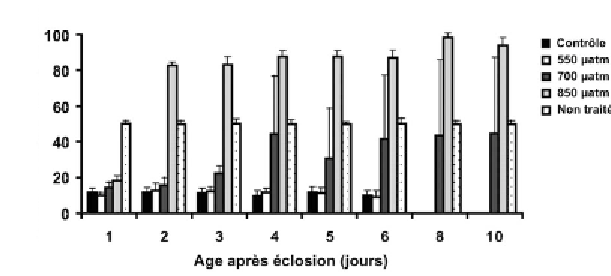Geoscience Reference
In-Depth Information
abilities [SIM 11] and behavior toward predators (Figure 5.9
[MUN 10]). These effects are associated with the inhibition of certain
neurotransmitters [NIL 12] and could have a negative impact on reef
fish populations and their recruitment [MUN 10].
Control
550
μ
atm
700
μ
atm
850
μ
atm
Untreated
Age post hatching (days)
Figure 5.9.
Effects of elevated CO
2
concentrations on olfactory ability of clownfish
larvae. Clownfish were exposed to 390 (control), 550, 700 or 850 ppm CO
2
from
hatching, and their behavioral responses were assessed at regular ontogenetic stages
using a flume chamber where they could freely move between a stream of water
containing the predator cue and a stream of water without the cue. Shown is mean
time (±SD) that clownfish larvae spent in the stream of water containing the predator
odor. The untreated category shows the time larvae spent on one side of the chamber
when neither water stream contained the predator cue. according to [MUN 10]
5.4.1.2.
Benthic ecosystems
5.4.1.2.1. Macroalgae and seagrasses
The positive effect of the enrichment in CO
2
on photosynthesis has
been observed in certain macroalgae (e.g. [GAO 93]) and marine plants
(e.g. [PAL 07]). The phanerogam
Posidonia oceanica
, an iconic plant
of the Mediterranean that is lacking an efficient carbon concentration
system, seems to benefit from the natural increase in CO
2
next to CO
2
vents, in contrast to calcareous algae and animals (Figure 5.10,
[HAL 08]), including those living on the fronds of Posidonia
(calcareous epiphytes, [MAR 08]). A recent study has highlighted a
negative effect of decreased pH on a phanerogam: a large decrease in
phenolic compounds as a function of increasing pCO
2
[ARN 12]. Yet,
these substances protect leaves from grazing, which suggests that




